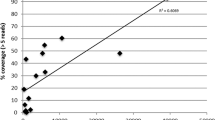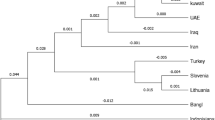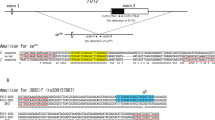Abstract
Distribution of a 27-bp deletion in the band 3 gene (B3Δ27) that causes Southeast Asian/Melanesian ovalocytosis has scarcely been studied in remote insular Southeast Asia and New Guinea. Here the presence of the B3Δ27 was surveyed among a total of 756 subjects from the indigenous populations inhabiting New Guinean islands and remote insular Southeast Asia by using a polymerase chain reaction method. In remote insular Southeast Asia where Austronesian-speaking peoples inhabit, the B3Δ27 frequency ranged between 0.04 and 0.15. In New Guinea Island, hinterland or Papuan groups showed the absence of the B3Δ27 or a very low gene frequency (0.01 in the Gidra) of the B3Δ27. However, groups of the coastal regions (Asmat, Sorong, and others) and of the nearby islands (Biak and Manus) where Austronesian infiltration had occurred showed substantial frequencies of the deletion (0.02–0.09). It is likely that the B3Δ27 was introduced into this region about 3,500 years ago with the arrival of Austronesian-speaking peoples. Once being introduced, the B3Δ27 may have been selected because of its resistance against malaria, while founder effect and genetic drift might have occurred in the New Guinean tribes with small population size, which helped to generate a variety of the B3Δ27 frequencies.
Similar content being viewed by others
Introduction
Southeast Asian/Melanesian ovalocytosis (SAO) is a clinically asymptomatic hereditary trait with an oval shape of erythrocytes. Prevalence of ovalocytosis ranging between 0 and 30% has been reported among several populations living in malaria-endemic areas in Southeast Asia and Melanesia (Lie-Injo 1976; Amato and Booth 1977), and its resistance against malaria has been postulated (Serjeantson et al. 1977; Foo et al. 1992).
Molecular studies revealed that a 27-bp deletion in the band 3 gene (B3Δ27), which results in a 9 amino acid deletion (400–408) in band 3 protein on the erythrocyte membrane, is a genetic basis for SAO in the heterozygous state (Jarolim et al. 1991; Tanner et al. 1991). Since the homozygous state for the deletion was suggested to be lethal (Liu et al. 1994) and SAO caused by the B3Δ27 shows a protective effect against cerebral malaria (Allen et al. 1999), the B3Δ27 is suggested to be a balanced polymorphism under the selective pressure of the malarial condition. High prevalence of ovalocytosis in Southeast Asia and Melanesia has been reported by microscopic studies (Lie-Injo 1976; Amato and Booth 1977); however, a molecular survey for the B3Δ27 revealed much lower frequencies of the B3Δ27 in Southeast Asian populations (Kimura et al. 1998). Erythrocyte shape is modified not only by the band 3 protein alteration, but also by other genetic and/or epigenetic factors (O’Donnell et al. 1998); in fact, we have encountered ovalocytosis without the B3Δ27 during our studies in the Asian Pacific region (Kimura et al. in preparation). Molecular identification of the B3Δ27 is important when we study SAO in relation with malaria because different molecular bases for SAO may contribute to the resistance against malaria in different manners and degrees.
Surveys for the prevalence of SAO or the B3Δ27 in insular Southeast Asia and Papua New Guinea were limited to some regions. In this study, to picture out a distribution of the B3Δ27 in Southeast Asia and Melanesia, we conducted a survey for the B3Δ27 among several indigenous populations of New Guinean islands and remote insular Southeast Asia.
Subjects and methods
A total of 756 individuals from East Timor (n=105), Seram Island (n=50), Flores Island (n=91), New Guinea Island (n=408), Biak Island (n=27), and Manus Island (n=75) were studied (Fig. 1). After informed consent was given, finger-prick blood or peripheral venous blood was collected. As for subjects from New Guinea Island, they were categorized according to their declaration of population name and/or birthplace. In Indonesian territory (Papua), subjects were from the central highland, known as the Dani group (n=147); northeastern coastal area, represented by Sorong (n=12); northern coastal area, represented by Jayapura (n=10); and Asmat region in the southern coastal area (n=15). In Papua New Guinea, subjects were from the Gidra group (n=187) in southern lowland region, hinterland (n=8), and the northeastern to eastern coastal area (n=29). DNA samples of Seram and Flores Islanders were kindly provided by Dr. M. Hirai of the University of Tokyo.
Location and gene frequency of the B3Δ27 in the population studied. *The gene frequency (0.09) for coastal region of New Guinea mainland is the average value of northeastern area, Sorong (1/12), southern area, Asmat (5/15), and others (6/39) (Number of subjects with B3Δ27/number of subjects studied)
DNAs were extracted from blood specimens with the NaI method or the standard phenol/chloroform method. A polymerase chain reaction (PCR) screening for the B3Δ27 was performed with specific primers (5’-GGGCCCAGATGACCCTCTGC-3’ and 5’-GCCGAAGGTGATGGCGGGTG-3’) that span the 27-bp deletion. An initial denaturation at 95oC for 5 min was followed by 40 cycles of denaturation at 94oC for 1 min and annealing and extension at 70oC for 1 min, with a final extension at 70oC for 5 min. The PCR products were separated on 2.5% agarose gel to identify the presence of 175 bp (normal) and 148 bp (deletion type) band.
Results
Among 756 subjects in remote insular Southeast Asia and New Guinea, the B3Δ27 was identified with various frequencies ranging from 0.0 to 0.15 (Table 1, Fig. 1). In remote insular Southeast Asia, the B3Δ27 frequency ranged between 0.04 (Timor) and 0.15 (Seram). In New Guinea Island, hinterland or Papuan groups showed the absence of the B3Δ27 (in the Dani) and a very low frequency (0.01) in the Gidra. However, groups of the coastal regions (Asmat, Sorong and others) and of the nearby islands (Biak and Manus) showed substantial frequencies of the deletion (0.02–0.09)
Discussion
SAO has been reported from many places in Southeast Asia and Melanesia with various frequencies by the microscopic studies. However, the B3Δ27, a molecular basis for SAO, is rarely found in Southeast Asian populations (Kimura et al. 1998). Little was known about the prevalence of the B3Δ27 in remote Southeast Asia facing to Melanesia, where we conducted a molecular survey. It was shown that the B3Δ27 is resistant against cerebral malaria in the heterozygous state (Allen et al. 1999) while homozygotes are thought to be lethal (Liu et al. 1994). The latter condition leads to a decrease in the frequency of the B3Δ27, whereas the B3Δ27 allele tends to be maintained in the population as a balanced polymorphism in the cerebral-malaria-endemic areas. The higher frequencies of the B3Δ27 could be attributed to a stronger selection by malarial condition. In fact, a study of the B3Δ27 in Papua New Guineans showed a correlation between the prevalence of the B3Δ27 and the altitude of their location, which at the same time correlated with malaria endemicity (Mgone et al. 1996).
In the present study, the pattern of the B3Δ27 distribution in mainland New Guinea (lower in the highlands and higher in the coastal regions) seems to correspond to the malaria hypothesis. However, a unique population structure of New Guinea must be taken into consideration. In New Guinea, populations have been linguistically classified into two main phyla: the non-Austronesian group, also referred to as Papuan, and the Austronesian group (Ruhlen 1991). Not only linguistic, but morphologic and genetic studies also suggest distinctive characteristics of the people of these two phyla. Sea dwellers who bore the Lapita culture introduced the Austronesian language as well as their genetic traits into this region about 3,500 years ago (Bellwood 1989). A recent study on mitochondrial DNA suggested that the Dani and the Asmat shared a common Papuan ancestor (Timmaseo-Ponzetta et al. 2002); however, the B3Δ27 was found in the Asmat but not in the Dani. Austronesian infiltration into New Guinea has genetically been demonstrated in the Asmat and the Gidra as well as in the populations inhabiting nearby islands, but not in the Dani (Ohashi et al., 2000; Nakayama et al. unpublished data). The distribution of the B3Δ27 in New Guinea is geographically well coincided with that of Austronesian genetic traits, such as HLA-DRB1. If the invasion of the Austronesian-speaking peoples was limited to the coastal region, the current distribution of the B3Δ27 is agreeable. In fact, South Pacific islands, such as Seram, Flores, and Timor where high prevalence of the B3Δ27 are recorded in the present study, are mainly occupied by Austronesian-speaking peoples. It is thus conceivable that people from remote insular Southeast Asia who bear the deletion dispersed into New Guinea to introduce their genes.
There is another supportive evidence for the introduction of the B3Δ27 by Austronesian-speaking peoples. The presence of the B3Δ27 has been reported out of Southeast Asia and Melanesia, such as in Madagascar and South Africa, where Austronesian-speaking peoples migrated or visited in the historical era (Rabe et al. 2002, Coetzer et al. 1996). As the B3Δ27 is associated with band 3 Memphis polymorphism (Lys56Glu), B3Δ27 is thought to have occurred on the genetic background of band 3 Memphis, which implies a single origin of the B3Δ27 (Jarolim et al. 1991). Therefore, clustering or sporadic distribution of the B3Δ27 is well interpreted by the dispersal of Austronesian-speaking peoples.
Our interpretation does not deny the positive selection of the B3Δ27 by malarial condition; homozygous lethality of the B3Δ27 can simply decrease the frequency to less than 1% from its maximum frequency within a hundred generations, or about 2,000 years, in the absence of positive selections. Without positive selection by the malarial condition, the current prevalence of the B3Δ27 is mysterious. Therefore, gene flow from Austronesian immigrants as well as selection by malaria should have played a very important role in the formation of present-day distribution of the B3Δ27.
From all these aspects, it is likely that the B3Δ27 was introduced into this region about 3,500 years ago with the arrival of Austronesian-speaking peoples. Once being introduced, the B3Δ27 may have been selected because of its resistance against malaria, while founder effect and genetic drift might have occurred in the New Guinean tribes with small population size and helped to generate a variety of B3Δ27 frequencies.
References
Allen SJ, O’Donnell A, Alexander ND, Mgone CS, Peto TE, Clegg JB, Alpers MP, Weatherall DJ (1999) Prevention of cerebral malaria in children in Papua New Guinea by Southeast Asian ovalocytosis band 3. Am J Trop Med Hyg 60:1056–1060
Amato D, Booth PB (1977) Hereditary ovalocytosis in Melanesians. PNG Med J 20:26–32
Bellwood PS (1989) The colonization of the Pacific: some current hypothesis. In: Hill AVS, Serjeantson SW (eds) The colonization of the Pacific: a genetic trail. Clarendon, Oxford, pp 1–59
Coetzer TL, Beeton L, van Zyl D, Field SP, Agherdien A, Smart E, Daniels GL (1996) Southeast Asian ovalocytosis in a South African kindred with hemolytic anemia. Blood 87:1656–1657
Foo LC, Rekhraj V, Chiang GL, Mak JW (1992) Ovalocytosis protects against severe malaria parasitemia in the Malayan aborigines. Am J Trop Med Hyg 47:271–275
Jarolim P, Palek J, Amato D, Hassan K, Sapak P, Nurse GT, Rubin HL, Zhai S, Sahr KE, Liu SC (1991) Deletion in erythrocyte band 3 gene in malaria-resistant Southeast Asian ovalocytosis. Proc Natl Acad Sci USA 88:11022–11026
Kimura M, Shimizu Y, S-Ishida W, Soemantri A, Tiwawech D, Romphruk A, Duangchan P, Ishida T (1998) Twenty-seven base pair deletion in erythrocyte band 3 protein gene responsible for Southeast Asian ovalocytosis is not common among Southeast Asians. Hum Biol 70:993–1000
Lie-Injo LE (1976) Genetic relationship of several aboriginal groups in South East Asia. In: Kirk RL, Thorne AG (eds) The origin of the Australians. Humanities Press, Canberra, pp 277–306
Liu SC, Jarolim P, Rubin HL, Palek J, Amato D, Hassan K (1994) The homozygous state for the band 3 protein mutation in Southeast Asian ovalocytosis may be lethal. Blood 84:3590–3591
Mgone CS, Koki G, Paniu MM, Kono J, Bhatia KK, Genton B, Alexander ND, Alpers MP (1996) Occurrence of the erythrocyte band 3 (AE1) gene deletion in relation to malaria endemicity in Papua New Guinea. Trans Roy Soc Trop Med Hyg 90:228–231
Ohashi J, Yoshida M, Ohtsuka R, Nakazawa M, Juji T, Tokunaga K (2000) Analysis of HLA-DRB1 polymorphism in the Gidra of Papua New Guinea. Hum Biol 72:337–347
O’Donnell A, Allen SJ, Mgone CS, Martinson JJ, Clegg JB, Weatherall DJ (1998) Red cell morphology and malaria anaemia in children with Southeast-Asian ovalocytosis band 3 in Papua New Guinea. Br J Haematol 101:407–412
Rabe T, Jambou R, Rabarijaona L, Raharimalala L, Rason MA, Ariey F, Dhermy D (2002) South-East Asian ovalocytosis among the population of the Highlands of Madagascar: a vestige of the island’s settlement. Trans Roy Trop Med Hyg 96:143–144
Ruhlen M (1991) A guide to the world’s languages. vol 1: classification. Stanford University Press, California
Serjeantson S, Bryson K, Amato D, Babona D (1977) Malaria and ovalocytosis. Hum Genet 37:161–167
Tanner MJA, Bruce L, Martin PG, Reardon DM, Jones GL (1991) Melanesian hereditary ovalocytosis have a deletion in red cell band 3. Blood 78:2786–2786
Timmaseo-Ponzetta M, Attimonelli M, De Robertis M, Tanzariello F, Saccone C (2002) Mitochondrial DNA variability of West New Guinea populations. Am J Phys Anthrop 117:49–67
Acknowledgements
We are most grateful to those who provided samples for our study. This research was partly supported by the Japan Society for Promotion of Science, Ministry of Education, Culture, Sports, Science, and Technology, Japan; and the University of Tokyo.
Author information
Authors and Affiliations
Corresponding author
Rights and permissions
About this article
Cite this article
Kimura, M., Tamam, M., Soemantri, A. et al. Distribution of a 27-bp deletion in the band 3 gene in South Pacific islanders. J Hum Genet 48, 642–645 (2003). https://doi.org/10.1007/s10038-003-0093-4
Received:
Accepted:
Published:
Issue Date:
DOI: https://doi.org/10.1007/s10038-003-0093-4
Keywords
This article is cited by
-
Genetic continuity across a deeply divergent linguistic contact zone in North Maluku, Indonesia
BMC Genetics (2011)
-
Molecular population genetics of SLC4A1 and Southeast Asian Ovalocytosis
Journal of Human Genetics (2009)
-
Malaria in Pacific populations: seen but not heard?
Journal of Population Research (2009)
-
The genotypes of GYPA and GYPB carrying the MNSs antigens are not associated with cerebral malaria
Journal of Human Genetics (2007)
-
Austronesian origin of the 27-bp deletion of the erythrocyte band 3 gene in East Sepik, Papua New Guinea inferred from mtDNA analysis
Journal of Human Genetics (2006)




